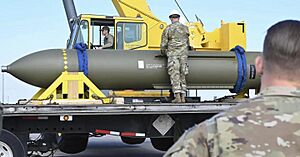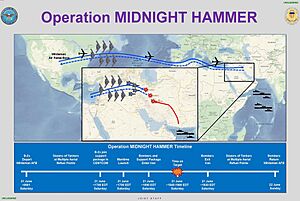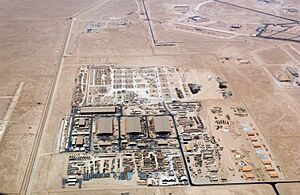United States strikes on Iranian nuclear sites facts for kids
Quick facts for kids United States strikes on Iranian nuclear sites |
|
|---|---|
| Part of the Iran–Israel war | |
| Location | Fordow, Natanz, and Isfahan, Iran |
| Planned by | |
| Commanded by | Donald Trump Anthony J. Cotton Michael Kurilla |
| Objective | Destruction of Iran's nuclear facilities |
| Date | June 22, 2025 02:10–02:35 (IRST) |
| Executed by | |
| Outcome | Iranian strikes on Al Udeid Air Base in Qatar
Per U.S.:
Per Iran:
Per the IAEA:
|
| Casualties | None |
On June 22, 2025, the United States Air Force and Navy attacked three important nuclear sites in Iran. This operation, called Operation Midnight Hammer, was part of the Iran–Israel war. The main targets were the Fordow Uranium Enrichment Plant, the Natanz Nuclear Facility, and the Isfahan Nuclear Technology Center.
The U.S. used powerful "bunker buster" bombs, weighing about 30,000 pounds (14,000 kg), dropped from Northrop B-2 Spirit stealth bombers. They also fired Tomahawk missiles from a submarine. This attack was the only offensive action by the United States in the Iran–Israel war, which started on June 13 and ended with a ceasefire on June 24, 2025.
U.S. President Donald Trump stated that Iran's main nuclear facilities were "completely and totally obliterated." Iran's Foreign Minister Abbas Araghchi confirmed that the sites had serious damage. After the strikes, Iran responded by attacking a U.S. base in Qatar. The next day, a ceasefire was announced between Iran and Israel. On July 2, Iran stopped working with the International Atomic Energy Agency (IAEA), which checks nuclear programs.
Contents
Why the Strikes Happened
Iran's Nuclear Program and Relations with the U.S.
Iran's nuclear program began with help from the U.S. in the 1950s, as part of a program called "Atoms for Peace" to promote peaceful nuclear science. In 1968, Iran signed the Non-Proliferation Treaty (NPT), agreeing not to develop nuclear weapons.
Later, Iran planned to build many nuclear power plants for electricity. After the Iranian Revolution in 1979, Iran's new leaders continued their nuclear program, saying it was for electricity and defense.
In 2015, Iran and several world powers, including the U.S. (under President Barack Obama), made a deal called the Joint Comprehensive Plan of Action (JCPOA). This agreement limited Iran's nuclear program for 15 years in exchange for removing economic sanctions.
In 2018, President Trump pulled the United States out of the JCPOA. He believed the deal was not stopping Iran from developing nuclear weapons. This meant sanctions against Iran were put back in place, making it harder for Iran to trade with other countries.
By May 2025, the IAEA reported that Iran had greatly increased its supply of uranium enriched to 60% purity, which is close to what is needed for weapons. This amount was enough for several nuclear weapons if enriched further. Iran said it increased enrichment because the U.S. left the JCPOA. The IAEA also said Iran was not fully cooperating with inspections.
One major Iranian nuclear site, Fordow Uranium Enrichment Plant, is located deep underground, about 80 to 90 meters (260-300 feet) below the surface. Because of its depth, U.S. military officials suggested using special "bunker buster" bombs, which only B-2 bombers can carry. The U.S. is the only country with these capabilities.
Israel's Role and U.S. Relations
Israel believes that if countries in the Middle East get nuclear weapons, it would be a huge danger. Israel itself is widely thought to have nuclear weapons, though it has never officially confirmed it. Israel has previously attacked nuclear facilities in Iraq and Syria to stop them from getting nuclear weapons. It has also been involved in killing Iranian nuclear scientists.
The conflict between Iran and Israel had been growing since October 2023. The U.S. has historically supported Israel, providing military aid and backing its actions. When Israel started the Iran–Israel war, it encouraged the U.S. to join.
Preparing for the Strikes
In the weeks before June 22, 2025, the U.S. took steps to protect its citizens in the region, like issuing travel warnings and moving non-essential staff from embassies.
Iran also made preparations. It increased its oil exports, fearing attacks on its oil facilities. Iran claimed it had moved nuclear materials from Fordow and Natanz to other locations. Days before the attack, Iranians tried to cover the ventilation shafts at Fordow with concrete caps.
The Fordow nuclear facility is very strong and deep inside a mountain. To damage it, heavy "bunker buster" bombs like the GBU-57A/B MOP were needed. These bombs had never been used in combat before and can only be carried by B-2 stealth bombers, which only the U.S. has. The U.S. and Israeli militaries had practiced this type of attack in mid-2024.
U.S. military experts had studied the Fordow site for about 15 years. Their work helped create the bunker-buster bomb specifically designed to break through strong defenses like Fordow. They monitored every part of the facility, believing it was not for peaceful purposes.
On June 16, 2025, the U.S. began moving many air tankers over the Atlantic Ocean towards Europe, which was unusual. This suggested a large military operation was being prepared.
President Trump had initially said he would decide on military action within two weeks. However, this was later seen as a trick to surprise Iran. On June 19, Israeli officials urged Trump not to wait, saying they had a small window of opportunity. Trump was convinced to attack not just Fordow, but also other sites.
By June 20, final preparations for the mission were underway. On June 21, B-2 stealth bombers flew west over the Pacific Ocean towards Guam as a decoy. This was to keep the real mission secret. Only a very small number of planners knew the full details of the operation.
U.S. bases in the Middle East went on high alert. Many U.S. military aircraft at Al Udeid Air Base in Qatar were moved, likely to protect them from Iranian retaliation.
The Strikes
The "Midnight Hammer" operation began on June 22. Seven B-2 bombers flew from Whiteman Air Force Base in Missouri for 18 hours, refueling in the air multiple times. Before the B-2s, U.S. fighter jets like the F-35 and F-22 flew into Iranian airspace. Their job was to draw out any Iranian air defenses. No Iranian defenses were detected, possibly because of earlier Israeli attacks on Iran's air defense systems.
At 2:10 a.m. Iran Standard Time, six B-2s dropped twelve GBU-57A/B MOP bombs on the Fordow facility. The seventh B-2 dropped two MOPs on Natanz. At Fordow, the bombs were dropped one after another into two ventilation shafts to go deep into the mountain. A submarine also fired 30 Tomahawk missiles at the Natanz and Isfahan sites. The entire bombing lasted almost 30 minutes.
The B-2 bombers flew for about 37 hours in total. Around 125 aircraft were involved in the operation, including refueling and surveillance planes. Both male and female pilots were part of the mission.
Damage Caused


Satellite images of the Fordow site after the strikes showed clear bomb entry points and ash. U.S. officials stated that the Iranian nuclear sites suffered "severe damage." An early U.S. intelligence report suggested the strikes set back Iran's nuclear program by months. However, later assessments by the Pentagon and Trump administration officials said the damage was more severe, setting back Iran's program by one to two years.
On June 25, Iran's Foreign Ministry spokesman Esmail Baghaei confirmed that Iranian nuclear facilities "have been badly damaged." The IAEA director general, Rafael Grossi, also said the sites suffered "severe damage."
What Happened Next
U.S. Statements
After the strikes, President Trump posted on social media, saying the attack on the three nuclear sites was "very successful." He also gave a televised address, calling the strikes a "spectacular military success" and warning Iran of more attacks if it did not seek peace. He also stated that any retaliation by Iran would be met with much greater force.
U.S. officials later gave more details, calling it the "largest B-2 operational strike in U.S. history." They said the goal was not to change Iran's government. However, Trump later suggested he would be open to seeing a change in Iran's leadership.
U.S. officials also admitted they did not know where Iran's enriched uranium stockpile was, believing it had likely been moved before the strikes. The Trump administration stated it was still open to diplomacy with Iran, but no meetings were scheduled.
On June 27, Trump said he would "absolutely" consider bombing Iranian nuclear sites again if needed. He also criticized Iran's Supreme Leader Ali Khamenei for his defiant comments.
Iranian Response
Iran's state media reported that there was no radioactive material at the targeted sites. Iranian officials also said there was no danger to people living near the nuclear facilities. They claimed nuclear material had been moved before the attacks.
On June 22, Iranian media reported that Majid Masibi, accused of spying for Israel, had been executed.
On June 22, the Iranian parliament voted to consider closing the Strait of Hormuz, a vital shipping route for oil. This vote was important politically, but the measure still needed final approval. Shipping continued through the strait, but with increased caution.
On June 23, Iran attacked a U.S. base in Qatar in response to the U.S. strikes. Qatar closed its airspace and claimed to have stopped all missiles. After this attack, several other countries in the region also closed their airspaces. The attack was widely criticized by Arab nations. The next day, a ceasefire between Iran and Israel was announced and confirmed by both sides, ending the conflict.
On June 26, Supreme Leader Khamenei spoke publicly for the first time since the ceasefire. He declared victory for Iran and said the attack on the U.S. base was a "slap in the face" to the U.S. He warned Iran would strike U.S. bases again if attacked in the future.
On July 2, Iran stopped cooperating with the International Atomic Energy Agency (IAEA). Iran said this would continue until its nuclear facilities and scientists were guaranteed safety.
Oil and Gas Prices
After the strikes, global oil prices were not greatly affected. The Strait of Hormuz remained open due to diplomatic efforts and the ceasefire. Oil prices even decreased in the days following the strikes.
Reactions from Around the World
United States
Security was increased around religious buildings in U.S. cities. The U.S. State Department also ordered family members and non-essential government staff to leave Lebanon. U.S. authorities arrested many Iranian nationals due to concerns about possible retaliatory attacks.
Many Republican politicians, including Lindsey Graham and Mike Johnson, praised the strikes, calling them "the right call" and a strong enforcement of the U.S. position against a nuclear-armed Iran. Some Democrats, like John Fetterman, also supported the strikes.
However, some commentators who usually support Trump, like Steve Bannon and Tucker Carlson, criticized the strikes, saying they went against Trump's past views on avoiding foreign wars.
Legal Concerns
The strikes led to a debate about whether the President has the power to order military actions without Congress's approval. Many Democratic lawmakers, like Jim Himes and Hakeem Jeffries, said Trump's actions violated the Constitution, which gives Congress the power to declare war. Some Republicans also raised concerns.
A poll showed that most Americans (65%) believed Trump should get Congress's approval for any future military action. On June 27, the U.S. Senate voted against a resolution that would have required the President to get Congress's approval before entering the Iran-Israel war.
Iran
Iranian Foreign Minister Abbas Araghchi called the strikes a "reckless violation of the UN Charter and international law." He stated that Iran would defend itself. Iranian officials claimed they were not surprised by the attack and had evacuated Fordow.
The Atomic Energy Organization of Iran (AEOI) called the U.S. attacks "barbaric" and a violation of international law. They said they would seek justice in international court and continue their nuclear program.
Israel
Israel closed its airspace after the strikes. Prime Minister Benjamin Netanyahu congratulated Trump, calling his decision "historic" and saying Trump had done what "no other country on earth could do." Other Israeli leaders also praised the U.S. action.
International Reactions
- United Nations: The UN Secretary-General António Guterres called the strikes a "dangerous escalation" and urged diplomacy. The United Nations Security Council held an emergency meeting.
- NATO: NATO Secretary General Mark Rutte praised Trump for his "decisive action."
- IAEA: The head of the IAEA, Rafael Grossi, warned that the attack "risks collapsing the global nuclear nonproliferation regime" and asked Iran to allow inspectors to assess the damage.
- European Commission: President Ursula von der Leyen stated that "Iran must never acquire the bomb."
Many countries expressed deep concern about the escalation. Some, like Albania, Argentina, Australia, and Germany, supported the U.S. action, emphasizing that Iran should not develop nuclear weapons. Others, like Bolivia, Brazil, China, Cuba, France, Iraq, Mexico, North Korea, Oman, Pakistan, Russia, and Saudi Arabia, condemned the strikes as a violation of international law and a threat to peace. They called for diplomacy and restraint.
Non-State Actors
Iran's allies in the region, known as the Axis of Resistance, condemned the strikes. Hamas and Hezbollah called the strikes "blatant aggression" and "barbaric." However, Hezbollah said it would not retaliate, stating Iran was strong enough to defend itself. The Houthis also condemned the strikes and threatened to end their ceasefire with the U.S.
See also
 In Spanish: Ataques de Estados Unidos contra Irán de 2025 para niños
In Spanish: Ataques de Estados Unidos contra Irán de 2025 para niños




